ဗိုလ္ခ်ဳပ္ေအာင္ဆန္း ႏွင့္တကြ အာဇာနည္ေခါင္းေဆာင္ၾကီးမ်ားကို လုပ္ၾကံသတ္ျဖတ္မႈတြင္ တရားခံတဦးျဖစ္ေသာ စိန္ၾကီး တြင္ ငယ္ရီးစာ တဦးရိွသည္။ သူအဖမ္းခံေနရခ်ိန္တြင္ထိုရီးစာမွာေနစဥ္လာေတြ့ေလ့ရိွသည္။ သူ ့ငယ္ရီးစားႏွင့္ စကားေျပာေနသည္မွာ ေကာလိပ္ေက်ာင္းသား ရီးစားႏွင့္စကားေျပာေနသကဲသို ့ရိွသည္ဟု ေရွမီွလူၾကီးမ်ားကဆိုသည္။ သူကိုၾကိဳးေပးျပီးသည့္အခ်ိန္တြင္အရက္တခြက္ႏွင့္ စီးကရက္ကိုမီးညိွထားရန္ သူရီးစားကိုမွာသည္။ ၾကိဳးေပးခါနီးတြင္ ရီးစားရဲ ့ပါးကို နမ္းခဲ့သည္။ ထူးဆန္းေသာ တိုက္ဆိုင္မႈမွာသူရဲ ့ရီးစားသည္ နအဖေခတ္တြင္ သစ္ေတာမ်ားကို ခုတ္ေရာင္းစားျပီး အဆမတန္ၾကြယ္၀ခ်မ္းသာလာေသာ ေဒၚထူး ပင္ျဖစ္ပါေတာ့သည္။
ေဒၚထူးရဲ ့သားမက္မွာလည္း ျပည္သူခ်ဥ္ပတ္အျဖစ္နာမည္ဆိုးျဖင့္ၾကြယ္၀ခ်မ္းသာလာေသာ ေတဇ ပင္ျဖစ္ပါေတာ့သည္။
(သမိုင္းသုေတသီ ကို သန္း၀င္းလိႈင္)





















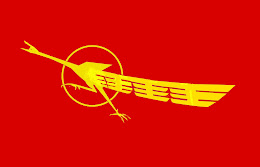





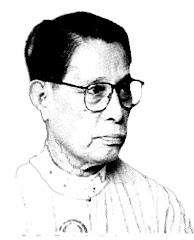


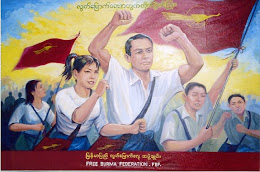





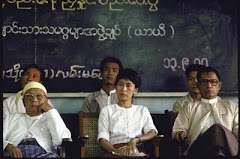

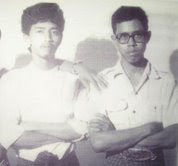

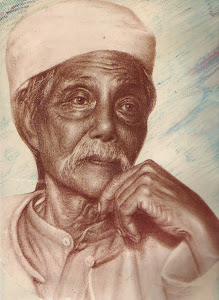
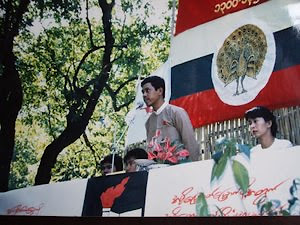
35 comments :
ေအာင္ဆန္းကို အၿငိဳးျဖင့္ သတ္ခိုင္းမည့္ သူမွာ အဂၤလိပ္ အစိုးရ မျဖစ္ႏိုင္ပါ။ ထိုေခတ္က ဂ်ပန္ ဖက္ဆစ္စစ္ဗိုလ္မ်ားသာ ျဖစ္ႏိုင္ပါသည္။ ေဒၚထူးသည္ ဂ်ပန္ စစ္ဗိုလ္ႏွင့္ အဆက္အႏြယ္ ရိွဖူးသသည္ဟု ဆိုပါသည္။ ေဒၚထူးသည္ ထိုဂ်ပန္ စစ္ဗိုလ္ ေၾကာင့္ ခ်မ္းသာလာခဲ့သည္။ ေတဇမွာ ေဒၚထူးကို အမွီျပဳၿပီး ေနာက္ပိုင္းမွ ႀကီးပြားလာျခင္း ျဖစ္သည္။ ဂ်ပန္စစ္ဗိုလ္ႏွင့္ ေဒၚထူးတို႔ ရႈပ္ဇာတ္သည္ ဗိုလ္ခ်ဳပ္ေအာင္ဆန္းတို႔ လုပ္ႀကံ ခံရမႈႏွင့္ ပတ္သက္မႈ အမ်ားႀကီး ရိွ ႏိုင္ပါသည္။
ေအာင္ဆန္းကို လန္ဒန္တြင္ ဖမ္းခ်ဳပ္ထားလိုက္၍ ရပါသည္။ ေသးသိမ္သည့္ လုပ္ႀကံမႈမ်ိဳးလုပ္ေနရန္လည္း မလိုပါ။ အေမရိကန္ပါဝင္ေသာ မဟာမိတ္တပ္မ်ားေၾကာင့္ ဂ်ပန္တို႔ စစ္႐ွံဴးၿပီး လြတ္လပ္ေရးေပးရန္ ျဖစ္လာခဲ့ပါသည္။ ျမန္မာလြတ္လပ္ေရး ရရိွျခင္းမွာ မဟာမိတ္တပ္မ်ား၏ ဖက္ဆစ္တိုက္ဖ်က္ေရး ဗ်ဴဟာေၾကာင့္ ျဖစ္ပါသည္။ ထို႔ေၾကာင့္ ဗိုလ္ခ်ဳပ္တို႔က မဟာမိတ္တပ္မ်ား၏ အကူအညီကို ရယူရန္ ဖက္ဆစ္တိုက္ဖ်က္ေရး အဖြဲ႕ ဖတပလ ကို ဖြဲ႕စည္း ခဲ့ျခင္း ျဖစ္ပါသည္။ ေနာက္ပိုင္း ဖက္ဆစ္ဆန္႔က်င္ေရးအဖြဲ႕ ဖဆပလ ဆိုၿပီးရပ္တည္ခဲ့သည္။ ထိုအခ်ိန္က ျမန္မာ့ တပ္မေတာ္မွာ အင္အား ေသာင္းဂဏန္း ပင္မရိွပါ။
ကမၻာကို အုပ္စိုးေနေသာ အဂၤလိပ္ စစ္အင္အားကို ယွဥ္ၿပိဳင္ တိုက္ခိုင္ အႏိုင္ယူႏိုင္ေသာ အင္အားမရိွပါ။ မဟာမိတ္ တပ္မ်ား ဖက္ဆစ္ကို ရွင္းလင္းတိုက္ထုတ္ၿပီးေနာက္ မဟာမိတ္တပ္မ်ား၏ ဆုလာဘ္ အေနျဖင့္ ျမန္မာ့ လြတ္လပ္ေရး ရလာခဲ့ျခင္းျဖစ္ပါသည္။ ထိုအခ်ိန္က ျမန္မာ့ တပ္မေတာ္တြင္ ဂ်ပန္ ႏွင့္ အဂၤလိပ္ တပ္မ်ားကို ယွဥ္တိုက္ ႏိုင္ေလာက္ေအာင္ စစ္ေလယာဥ္၊ စစ္သေဘၤာ၊ စစ္လက္နက္ မရိွပါ။ မဟာမိတ္ စစ္တပ္မ်ား၏ ေက်းဇူးေၾကာင့္ ဂ်ပန္ ဖက္ဆစ္ကို ျမန္မာျပည္မွ ေမာင္းထုတ္ႏိုင္ခဲ့ၿပီး ဖက္ဆစ္ဂ်ပန္ကို ေခ်မႈန္းရန္ ကူညီခဲ့သည့္ ဗိုလ္ခ်ဳပ္ဦးေဆာင္ေသာ ဖက္ဆစ္တိုက္ဖ်က္ေရး အဖြဲ႕၏ ေတာင္းဆိုမႈေၾကာင့္ ျမန္မာျပည္ လြတ္လပ္ေရး ဟူသည့္ ဆုလက္ေဆာင္ကို ျမန္မာတို႔ ကံေကာင္းစြာ ရခဲ့ျခင္း ျဖစ္ပါသည္။
ထို ေခ်မႈန္းသုတ္သင္ျခင္းကို ခံလိုက္ရေသာ ဂ်ပန္ စစ္ဗိုလ္တို႔သည္ ေအာင္ဆန္းကို အၿငိဳးအေတးႀကီးစြာ ထားမည္ျဖစ္သည္။ ဗိုလ္ခ်ဳပ္ကို လုပ္ႀကံရန္ ေနာက္ကြယ္မွ ႀကိဳးကိုင္သူသည္ အဂၤလိပ္ အစိုးရ မျဖစ္ႏိုင္ပါ။
Please watch you tube why Aung San was killed. All are explained. Both British and Japanese are colonial and they have colonial mind set, leave the country in a mess if they couldn't rule it.
I have a chat with uncles and their general knowledge is very good especially about the history. And his father in law is from Police force that time and he was assigned to follow up on General Aung San's assassination case. This was directed by then Police Chief General Tun Hla Aung because he wanted to know who is behind the scene of this assassination.
It might be deviated from the truth or the truth, I am not sure too. I just share with others and I felt it is logical and high possibility.
The idea to kill Bogoke was by the British Traders and businessmen who were well settled down in Myanmar. Because they think Bogoke will probably practice publicized those British assets in Myanmar once he came to power.
Attlee Govt has no intention to kill Bogoke. Japanese were too devastated with post war crisis and nothing to bother.
I felt it is pretty logical.
Truth or not, I have no idea.
Have your say...
တရားခံအစစ္ မ်ားမွာ
U SAW စီးနင္းလာေသာကား အား
ေခ်ာင္းေျမာင္းလုပ္ႀကံမွဳ အတု
အသက္ေသေစရန္ ရည္ရြယ္ခ်က္ျဖင့္ မဟုတ္္ပဲ
U SAW ဘဝတသက္တာ နာမည္ဆိုးတြင္ေစမည့္
ေအာင္ဆန္းရာ မင္းလူေတြငါ့ကို လုပ္ႀကံေပမည့္
ငါ မေသဘူး
ဒါေပ သိ မင္းကိုေတာ့ ငါ မရရေအာင္
သတ္ျပမယ္ ဟူေသာ
ေမာဟစိတ္+ေဒါသစိတ္
ျဖစ္ေပၚေစမည့္ လုပ္ရပ္ ကို ဖန္တီးခဲ့သူ မ်ားပင္
ျဖစ္ေပေတာ့သတည္း၊
စိန္ၾကီးသည္ ထိုလူယုတ္မာမ်ား၏ ဒလန္အျဖစ္
U SAW ေဒါသအား ဆြဆြေပး ရန္အနီးကပ္ တြန္းပိဳ့ ေပးသူအျဖစ္ ျဖစ္နိုင္ေခ် ရွိပါ၏။
THANKS FOR I CAN SHARE MY FEELING THAT I SUSPECTED NE WIN&HIS DONS&BOSSES!!!!
LATER ON ~~~~~~~~
NE WIN F~~~ED THEM!!!!
OR MIGHT BE HELPED THEM BEHIND THE DOOR!!!!!!!!!!!!!
LATER ON~~~~~~~~~~~
THAN SHWE F~~~ED HIS FACE!!!!!!!!!
SO NOW ON~~~~~~~~~~~
LET US SEE THAT WHO WILL F~~~
THAN SHWE & ENTIRE~~~~~~~~~~~
THIS IS ONLY MY VIEW!!!!!!
BUT THE FAKE ASSINATION TO U SAW WAS THE TRUTH!!!!!!
PLEASE ASK AN OLD AGE PEOPLE WHO NEVER SERVE IN MA SA LA မဆလ PARTY!!!!
THEY MAY KNOW ABOUT THAT EVENT!!!!!!
အကြက္ဆင္သူ
ုလူယုတ္မာ မ်ား၏
သားသမီး မ်ား မွာ ထိုု ျဖစ္ရပ္ ကိုသိရွိနုိင္ခဲ့မည္
မဟုတ္ေခ်
ယင္းတို ့၏ ဘခင္မ်ားအား
ယေန ့ထိတိုင္
~~~~~~~~
ႀကီးမ်ား အျဖစ္သာ သိရွိမွတ္ယူလွ်က္သာရွိေပေျခမည္ တကား!!!!!!!!!!!!!!!!!!!!!!!!!!!!!!!!!
ဒါေပသိ
ဗမာျပည္ႀကီး အတြက္
အစားထိုး မရပါေသာ
ဆုံးရွဴံး ျခင္း ျဖစ္ရပ္ ျဖစ္ပြါးခဲ့ကာ
ဖာနူိင္ငံသာ ျဖစ္လွ်က္ရွိေနပါသည္တကားးးးးးးးးးးးးးးးး
very very bad comments and amazingly look down the Burmese Defense Army,Chief General Aung San and his people of Burma,,,after 1948, this comments suddenly came out to public view.
Who wrote this comments should respect the people of Burma who lost and sacrificed their life for Burma Independence .Please respect the life lost of Burmese people during 1852 to 1948 and don't try to create the believe it or not movie again,in fact General Aung San created and left the well organized people who were ready to keep back their mother land from Foxy countries,Please study again who was the 1st Earl Mountbatten of Burma and why he respected General Aung San and the people,the country that time.Thought you never lost your ancestors during 1852 to 1948 that's why you have no sympathy and respect the lost of life at that time.Many thanks for your baseless comments here.
94 RIT!!!!!!!!!!!!!!!!!
if u say so!!!!!!!!!!!!!!!!!!!
I WANT TO MEET YOU !!!!!!!!!!!!
FOR THE RERASON YOU SAID BASELESSSSSSSSS!!!!!!!!!!!!!!!!!!!!!!!
Strange connections.The results is bad.
ဘမာျပည္ကိုဘီအိုင္ေအကလြတ္ေျမာက္ေအာင္လုပ္တယ္စိုတာ
ကဘမာသမိုင္းရဲ့အမားေတြ။မ်ိဳးခ်စ္ေစခ်င္ေတာ့မ်က္စိကန္းျပီးဝါဒေဝျဖန္႕တာ။
ျဖစ္ေနတာက ကဘာစစ္။ကဘာစစ္ေတာင္ဒုတိယကဘာစစ္\(ေခတ္မီတဲ့စစ္)။
ဂ်ပန္ကိုတိုက္ထုက္ဖို႕စိုတာကေခ်ာ္ကခြၽတ္တပ္ေလးေလာက္နဲ႕အလုပ္မျဖစ္ဘူး။
ဝင္းဂိတ္ရဲ့ရန္သူကိုအတြင္းစည္းကေနဝင္တိုက္တဲ့အေသခံရတဲ့ ျခင္ေတ့စစ္ဆင္ရေတြကိုလုပ္ရသလို။
အေမရိကန္ျဗိတိသွ်ေတြရဲ့ ေလတပ္၊ေရတပ္၊ၾကီးတပ္ေတြရဲ့သမား႐ိုးက်တိုက္ပြဲေတြရွိတဲ။
ဂ်ပန္ကိုတိုက္ထုက္တာဘီအိုင္ေအစိုတာကရီစရာသိက္ေကာင္းတယ္။
I AM ASKING NOW ONE QUESTION ONLY????
WHO DID IT TO U SAW????????
***YAMA MIN***
***YINN LAW WAN***
ဘမာျပည္ကိုဘီအိုင္ေအကလြတ္ေျမာက္ေအာင္လုပ္တယ္စိုတာ
ကဘမာသမိုင္းရဲ့အမားေတြ။
မ်ိဳးခ်စ္ေစခ်င္ေတာ့မ်က္စိကန္းျပီးဝါဒေဝျဖန္႕တာ။
ျဖစ္ေနတာက ကဘာစစ္။
ကဘာစစ္ေတာင္ဒုတိယကဘာစစ္\(ေခတ္မီတဲ့စစ္)။
ဂ်ပန္ကိုတိုက္ထုက္ဖို႕စိုတာ
ကေခ်ာ္ကခြၽတ္တပ္ေလးေလာက္နဲ႕အလုပ္မျဖစ္ဘူး။
ဝင္းဂိတ္ရဲ့ရန္သူကိုအတြင္းစည္းကေနဝင္တိုက္တဲ့
အေသခံရတဲ့ ျခင္ေတ့စစ္ဆင္ရေတြကိုလုပ္ရသလို။
အေမရိကန္ျဗိတိသွ်ေတြရဲ့ ေလတပ္၊ေရတပ္၊
ၾကီးတပ္ေတြရဲ့သမား႐ိုးက်တိုက္ပြဲေတြရွိတဲ။
ဂ်ပန္ကိုတိုက္ထုက္တာဘီအိုင္ေအစိုတာကရီစရာသိက္ေကာင္းတယ္
ၾကည့္လည္း လုပ္ၾကပါဦး... ေဒၚထူး နဲ႔ သူ႔ေယာကၤ်ားဟာ နအဖ အစုိးရတာင္ မတက္ရေသးဘူး ၈၈ မျဖစ္ခင္ အေစာႀကီးထဲက သူ႔ဇာတိၿမိဳ႔ႀကိဳ႔ပင္ေကာက္ကုိ အလႈကိစၥနဲ႔ အျပန္ ၿမိဳ႔အဝင္ ထမင္းဆုိင္မွာ ထမင္းစားေနၾကတုန္း ကားတုိက္ခံရၿပီး ပြဲခ်င္းၿပီးေသဆုံးသြားခဲ့တာပါ...။ ဂ်ပန္စစ္ဗုိလ္ နဲ႔ ေဒၚထူး ကိစၥလည္း တခါမွ မၾကားဘူးပါ။ ဘယ္ဂ်ပန္စစ္ဗုိလ္ကမွ မတာ မဟုတ္ပါ။ ဦးေအာင္ႀကီးႏွင့္ အရင္ထဲက ေဆြလုိမ်ိဳးလုိခင္ၾကၿပီး ဦးေအာင္ႀကီးေကာင္းစားခ်ိန္တြင္ မစခဲ့သျဖင့္လည္းေကာင္း ပင္ကုိယ္က စီးပြားေရး မ်က္စိ႐ွိသျဖင့္လည္းေကာင္း ခ်မ္းသာၾကြယ္ဝသြားျခင္းသာျဖစ္ပါသည္...။ သမုိင္းဆုိသည္ကုိ မွန္းၿပီး ထင္သည္ ယူဆရသည္ ဆုိသည္နွင့္မၿပီးပါ။
ေဒၚထူးက လမ္းေဘးမွာ မုန္႔ဟင္းခါးစားရင္း ကားတုိက္ခံရပီး ဆံုးတာဆုိ..
ဟုတ္တယ္ စားေသာက္ဆုိင္မွာ စားေနတုန္း လမ္းေပၚမွာ ေမာင္းလာတဲ့ကားက ဝင္တုိက္တာ ပြဲခ်င္းၿပီးပဲ မုန္႔ဟင္းခါးလား ထမင္းဆုိင္လားေတာ့ မသဲကြဲဘူး... ။ သူ႔တုိ႔လင္မယားနာမည္နဲ႔ လႈထားတဲ့ ေရစင္ႀကီး ႀကိဳ႔ပင္ေကာက္မွာ အရင္က ႐ွိတယ္... ခုေတာ့႐ွိေသးလား မ႐ွိလား ျမန္မာျပည္နဲ႔ေဝးလုိ႔ မသိေတာ့ဘူး...။
ဘုရား၊ ဘုရား၊ ဘုရား...
94 RIT!!!!!!!!!!!!!!!!!
if u say so!!!!!!!!!!!!!!!!!!!
I WANT TO MEET YOU !!!!!!!!!!!!
FOR THE RERASON YOU SAID BASELESSSSSSSSS!!!!!!!!!!!!!!!!!!!!!!!
Ok! Mr. Gentle Man,
One question only I wish to ask you !!! Who's your father? an English? an American? or Than Shwe?? Please respect the General Aung San and his Daughter that I highly appreciate form you if you are people of Burma otherwise you no need to comment on our Great Hero General Aung San and his army, his people effort during war time. thanks and hope your civilized response only and I won't try to talk with stone.
Burma, 1942
7 December 1941-26 May 1942
On 8 December 1941, after the surprise attack on Pearl Harbor, the United States declared war on Japan and became an active participant in World War II. For some months prior to that attack, however, the United States had been supporting China's war against Japan with money and materiel. Pearl Harbor formally brought America into World War II, but it was an earlier American commitment to China that drew the United States Army into the Burma Campaign of 1942.
Japan had invaded China in 1937, gradually isolating it from the rest of the world except for two tenuous supply lines: a narrow-gauge railway originating in Haiphong, French Indochina; and the Burma Road, an improved gravel highway linking Lashio in British Burma to Kunming in China. Along these routes traveled the materiel that made it possible for Chiang Kai-shek's Nationalist Chinese government to resist the Japanese offensives into the interior.
In 1940 Japan took advantage of the German invasion of France to cut both supply lines to China. In June, with France focused on the war in Europe, Japanese warships moved into French Indochina and closed the railroad from Haiphong. A month later, threatening war if its demands were not met, Japan secured an agreement from the hard-pressed British government to close the Burma Road to war materiel temporarily.
The Burma Road reopened in October 1940, literally the sole lifeline to China. By late 1941 the United States was shipping lend-lease materiel by sea to the Burmese port of Rangoon, where it was transferred to railroad cars for the trip to Lashio in northern Burma and finally carried by truck over the 712-mile-long Burma Road to Kunming. Over this narrow highway, trucks carried munitions and materiel to supply the Chinese Army, whose continuing strength in turn forced the Japanese to keep considerable numbers of ground forces stationed in China. Consequently, Japanese strategists decided to cut the Burma lifeline, gain complete control of China, and free their forces for use elsewhere in the Pacific.
Strategic Setting
Burma, a country slightly smaller in area than the state of Texas, lies imbedded in the underbelly of the Asian landmass between India and China. Along the northern, eastern, and western borders of Burma
are high mountains. The Himalayas to the north reach altitudes of 19,000 feet. The western mountains between Burma and India, forming the Burma-Java Arc, have pinnacles as high as 12,000 feet. On the east the Shan Plateau, between Burma and China, features relatively modest peaks of less than 9,000 feet. The Bay of Bengal and the Andaman Sea mark the southern boundary; on the southeast, Burma shares an extended border with Thailand. The central part of the country consists of north-south belts of fertile plains, river valleys, and deltas. Rainfall is heavy throughout the year. The Irrawaddy River and its major tributary, the Chindwin, drain the western portions of the country, and the Salween and Sittang Rivers drain the regions in the east.
4
The geography of Burma had isolated it from India and China, its larger and more populous neighbors. The high, rugged mountain ranges discouraged trade and travel. This lack of contact had shaped Burma into a country distinctly different from either of those larger neighbors, who in turn had little interest in Burma given the natural barriers to invasion. Japan's dramatic 1941 bid for dominance in the Far East, however, caused both India and China and their Western patrons, Great Britain and the United States, respectively, to focus attention on Burma.
At one time the British had attempted to govern Burma as a province of India, but the artificial mixing of the two cultures proved unworkable. In 1937 Burma had become a separate colony with a largely autonomous government. Its still-dependent status dissatisfied many of the more politically aware Burmese, who formed a vocal minority political party favoring complete independence from Britain. When a number of the leaders of this movement visited Tokyo in the years before 1941, Japanese government officials had expressed sympathy with their efforts to attain independence. Burma, however, was still very much a permanent possession in the eyes of Prime Minister Winston Churchill, who clearly had no intention of presiding over the dissolution of the British Empire. Churchill saw the status quo ante helium as a primary British war aim, with both India and Burma remaining colonies as they had been since 1941.
President Franklin D. Roosevelt had a different vision for postwar Asia. Roosevelt believed that the European empires in the Far East were archaic and that their colonies would soon be independent countries. He also wanted China treated as an equal Allied partner in the war against Japan in the hope that it would develop into a great power friendly to the West. On a more immediate and practical note, keeping China in the war would also keep a large contingent of Japanese ground forces occupied on the Asian mainland, out of the way of American operations in the Pacific.
Although Great Britain and the United States were pursuing the same strategic goal of ultimately defeating Japan, they disagreed about Burma's role in attaining that goal. Their leaders agreed that Burma should be defended against the Japanese, but their motives differed. For the British, Burma provided a convenient barrier between India, the "crown jewel" of their empire, and China with its Japanese military occupation. The Americans saw Burma as the lifeline that could provide China the means to throw off the shackles of Japanese occupation and become a viable member of the international community.
Despite the Allies' determination to hold Burma, their plans for the defense of the region were incomplete. The Burmese were not consulted and had little reason to fight the Japanese. More significantly, neither Britain nor the United States was prepared to commit significant forces to save the area. Japanese leaders, in contrast, were prepared to do more and viewed Burma as critical to their overall strategy for the war. The occupation of Burma would protect gains already secured in the southwest Pacific, set the stage for a possible invasion of India that conceivably could link up with a German drive out of the Middle East, and once and for all close the Allied supply line along the Burma Road into China.
Operations
Less than a week after the bombing of Pearl Harbor, Japanese planes took off from captured bases in Thailand and opened the invasion of Burma by bombing the Tavoy airdrome, a forward British outpost on the Andaman Sea south of Rangoon. The next day, 12 December 1941, small Japanese units began the ground offensive by infiltrating into Burma. Not having prepared for war, Imperial British forces in Burma lacked even such rudimentary necessities as an adequate military intelligence staff. Although a civil defense commissioner had been appointed in November 1941, the British had not made contingency arrangements, such as military control of the railroads and the inland waterways. The only British forces in Burma were a heterogeneous mixture of Burmese, British, and Indian units known as the Army in Burma. Their air support consisted of some sixteen obsolete Royal Air Force (RAF) fighters.
The only American combat force even remotely available at the onset of the fighting was the fledgling American Volunteer Group (AVG). Organized by retired Army Air Forces Col. Claire L. Chennault, with the approval of both the Chinese and American governments, the AVG was preparing to provide air support to the Chinese Army against the Japanese in China. The AVG had begun training during the summer of 1941 in Burma to be out of range of Japanese air raids until ready for combat.
Chennault had hoped to employ his three squadrons of fighter aircraft, after thorough training, as a single unit in China, but the outbreak of war in the Pacific and subsequent Japanese invasion of Burma quickly changed his priorities. In response to a British request for support on 12 December, one squadron of the AVG moved from the training base in Toungoo to Mingaladon, near Rangoon, to help protect the capital city
and its port facilities. The two remaining squadrons deployed to China to protect Chinese cities and patrol the Burma Road.
When Japan began operations in Burma, the United States recognized that the British would need assistance. The American Military Mission to China (AMMISCA), under Brig. Gen. John Magruder, had been in Chungking since September 1941 to coordinate, among other things, American lend-lease aid for China. On 16 December the War Department gave Magruder authority to transfer lend-lease materiel awaiting transportation in the port of Rangoon from Chinese to British control. The transfer, however, was subject to Chinese approval since, in accordance with lend-lease agreements, title for the materiel had been technically transferred to China when it left the United States.
Shortly after the War Department authorized the transfer, the responsible American officer in Rangoon, Lt. Col. Joseph J. Twitty, came under considerable pressure to release some of the weapons and equipment without waiting for Chinese approval. He responded by asking the government of Burma to impound and safeguard the materiel in Rangoon. He ostensibly made this request to ensure that the materiel was not moved elsewhere until Generalissimo Chiang Kai-shek, the ruler of Nationalist China, approved the transfer to the British. Not unexpectedly, the Chinese swiftly objected to the transfer. With little love for the British or their colonial objectives, the Chinese
government quickly labeled the arrangement "illegal confiscation." Because the most valuable materiel affected was a cargo of munitions on board the Tulsa, an American ship anchored in Rangoon harbor, the controversy became known as the Tulsa incident.
The senior Chinese representative in Rangoon, General Yu Feipeng, a cousin of the generalissimo, became the focal point of the affair. Colonel Twitty apparently convinced him that the materiel really had been impounded to safeguard it. Nevertheless, the Chinese authorities in Burma requested the establishment of a committee of experts from China, Britain, and the United States to determine the appropriate disposition of specific items of equipment. This suggestion was acted upon immediately, and by the time Magruder's headquarters in Chungking learned of the committee's existence, it was already busy deciding what to keep in Burma for British use and what to send on to China.
Magruder hoped to settle the question of providing Chinese lend-lease materiel to the British at a 23 December conference in Chungking, on the assumption that the Chinese had concurred with the actions already taken in Rangoon. Like many Americans, however, Magruder had much to learn about internal Chinese politico-military affairs. On Christmas Day, when the question of the sequestered materiel finally arose, Magruder was startled to hear the Chinese charge that the British had stolen Nationalist lend-lease stocks in Rangoon with American assistance. The generalissimo had decided that the seizure of the Tulsa cargo amounted to an unfriendly act and that all lend-lease materiel at Rangoon should therefore be given to the British or returned to the Americans. All Chinese personnel in Burma would return to China and all cooperation between China and Britain would cease.
Magruder immediately made conciliatory gestures to both the British and the Chinese in the hope of preventing an impending Allied rift. He gained an audience with the generalissimo and found him in a friendly mood. After listening to Magruder's assurances that all was well with the lend-lease program, the generalissimo announced that he had already approved the initial list of British requests for materiel. He also sanctioned the joint American, British, and Chinese allocation committee in Rangoon and suggested that it continue its work. In an apparent face-saving gesture for the Tulsa incident, the generalissimo insisted that Magruder replace Colonel Twitty. Magruder acquiesced, and eventually large amounts of lend-lease weapons and equipment, originally earmarked for Nationalist China, went to the British for use in the defense of Burma. The affair, however, typified the problems Americans would face when dealing with the mercurial Chiang Kai-shek.
9
The international tensions existing among the nations defending Burma would, in fact, bedevil the entire campaign. Abrupt changes of mind by Chiang Kai-shek, such as his apparent reversal on the Chinese lend-lease policy, were a constant source of irritation for American and British officers who could never be sure when they had a real decision from him. The Tulsa incident also emphasized the differences between the British and American policies regarding China. The British were fighting for the future of their empire in the Far East and had little concern for China. The Americans, sensitive about their treatment of China in the past, sought to make it a more equal member of the Alliance.
Other problems originated with the British, who were jealous of their imperial prerogatives. The Chinese were willing, even anxious, to provide troops to assist in the defense of Burma. The generalissimo offered two armies with the proviso that they would operate in designated areas under Chinese command and would not be committed to battle piecemeal. Reluctant at first to permit large Chinese forces to operate in Burma, the British agreed to accept only one division of Chinese troops. Field Marshal Sir Archibald P. Wavell, British commander in chief in India, believed the Japanese offensive in Burma was overextended and would only end in failure; Chinese forces were not required for victory. Accepting the use of one Chinese division, he judged, was an adequate response to the generalissimo's offer.
Although the British were lukewarm about Chinese participation in the defense of Burma, the Americans embraced the idea. When the Chinese threat of stopping cooperation with Britain after the Tulsa incident had reached the Allied Arcadia Conference in Washington, D.C., the Americans reacted with alarm, fearing China might actually elect to withdraw from the war. This fear was exacerbated by the continuing string of Japanese successes in the Pacific (Hong Kong had surrendered on Christmas Day and Manila was declared an open city the next day).
Roosevelt, a long-time China booster, convinced Churchill to appease the generalissimo by inviting him to serve as supreme commander of Allied forces in a separate China theater. The offer was somewhat hollow, since there had never been any plan to put British or American forces into China and there would be no Chinese participation in the Allied Combined Chiefs of Staff. Nevertheless, the generalissimo accepted the offer and even requested an American officer to head the Allied staff.
After some discussion, the War Department nominated Maj. Gen. Joseph W. Stilwell to the Chinese government to be the Allied chief of staff. Stilwell's numerous tours on the Asian mainland had made him
10
extremely knowledgeable about the Chinese Army. However, he was somewhat less than enthusiastic about the position, since he had already been tentatively selected to command the Allied invasion of North Africa. When Army Chief of Staff General George C. Marshall informed him of his new posting on 23 January 1942, a disappointed Stilwell simply replied, "I'll go where I'm sent."
Stilwell's misgivings proved well founded. His specific command authority was vague from the beginning. Prior to his appointment, the War Department had received Chinese approval for Stilwell to command the Chinese forces sent to Burma, or at least to have "executive control" over them. But executive control would turn out to be a rather vaguely defined term that would lead to considerable confusion and much rancor between Stilwell and the Chinese.
Stilwell's assignment orders designated him "Chief of Staff to the Supreme Commander of the Chinese Theater." When he reported to the Chinese theater, his orders designated him "Commanding General of the United States Forces in the Chinese Theater of Operations, Burma, and India." The orders did not address the specific duties implicit in these positions, especially his relationship with British theater commands. Nevertheless, with the prospect of commanding Chinese forces in Burma, Stilwell planned to organize his staff along the lines of a corps headquarters. Before his departure for the Far East, he had received the approval of the War Department to designate his headquarters, to include any U.S. forces that might join him, the United States Task Force in China.
Even as Stilwell assembled his staff in Washington and began the long journey to the China-Burma-India (CBI) Theater of Operations, the situation in Burma was deteriorating rapidly. After a round of meetings in Washington, which included President Roosevelt, the secretary of war, and various Chinese diplomats, Stilwell and his staff left Florida on 13 February 1942, appropriately enough a Friday.
As the party traveled to the Far East, accomplishing the twelve-day trip in a series of plane rides through the Caribbean to South America, over to Africa, and across the Middle East, Japanese successes in the CBI theater continued to mount. Singapore surrendered with 80,000 troops on 15 February; eight days later the British-Indian brigades in Burma were crushed in the Battle of the Sittang Bridge, a defeat that effectively left the path to Rangoon open to the Japanese advance. On 25 February, the Australian-British-Dutch-American Command (ABDACOM), the Allied command established on 15 January to defend the region, was dissolved in the face of continued Japanese pressure. Although Stilwell was assigned duties in China,
11
Japanese troops firing a heavy machine gun.
Japanese troops firing a heavy machine gun. (National Archives)
events in Burma thus dominated his first months as Chiang Kai-shek's Allied chief of staff.
With Rangoon threatened, Magruder ordered the destruction of all lend-lease stocks in an effort to deny them to the invading Japanese. As the Japanese approached, there had been frantic activity to move as much materiel as possible north to the Burma Road, but it was still necessary to destroy more than 900 trucks in various stages of assembly, 5,000 tires, 1,000 blankets and sheets, and more than a ton of miscellaneous items. Magruder transferred much materiel to the British forces, including 300 British-made Bren guns with 3 million rounds of ammunition, 1,000 machine guns with 180,000 rounds of ammunition, 260 jeeps, 683 trucks, and 100 field telephones. In spite of the destruction and transfer to the British, however, over 19,000 tons of lend-lease materiel remained in Rangoon when it fell to the Japanese on 8 March.
As Stilwell prepared for his new assignment, the 10th U.S. Air Force was activated in Ohio and slated for deployment to the CBI
12
Crew chief indicated a P-40 polot's scores.
Crew chief indicates a P-40 pilot's scores. (National Archives)
Theater of Operations. The 10th was to be based in India with the mission of supporting China. Maj. Gen. Lewis H. Brereton, an airman experienced in fighting the Japanese in the Netherlands East Indies, assumed command of the new air force when it arrived in India in early March 1942. Although the 10th Air Force was assigned to the CBI to support the Chinese, the Japanese offensive in Burma meant that Brereton's bombers would be supporting the interests of two major Allies, China and Great Britain.
About the only good news in Burma in early March was that Chinese troops were soon expected to enter the defensive campaign. Chiang Kai-shek had agreed that Stilwell would command Chinese forces sent to Burma, and in the press of the military emergency, Chiang Kai-shek and the British had even come to an agreement on the use of these forces. During February, the 5th and 6th Chinese Armies, each with three divisions, slowly began moving into Burma. The 5th was the stronger of the two, with three divisions at full strength, one of which
Read more about it @ http://www.history.army.mil/brochures/burma42/burma42.htm
ေဒၚထူးက ကားလမ္းေဘးကထမင္းဆိုင္မွာ ၀ါတီးဆဲြေနတုန္ ကုန္ကားကဘရိတ္ေပါက္ၿပီး ဆိုင္ထဲကို၀င္တိုက္တာ ေဒၚထူးကိုမ်က္ႏွာၿခင္းဆိုင္၀င္တိုက္တာ၊ အဲဒီအခ်ိန္မွာ ေတဇာက ေဒၚထူးပိုင္ဆန္စက္မွာ မန္ေနဂ်ာ ေနာက္ေတာ့ က်န္ေနခဲ့တဲ့ ေဒၚထူးသမီးနဲ့ညာတာပါးးးးးေအာင္ၾကီးနဲ ့ေဒၚထူး ေန၀င္းလက္ထက္က ဂ်ပန္ကစစ္ေလ်ာ္ေၾကးအၿဖင့္ေပးတဲ ့ဂ်ပန္ကာအသစ္ေတြကို ေအာင္ၾကီးနဲ့ေပါင္းၿပိး ကားအသစ္ေတြကိုေ၇ာင္း အေဟာင္းေတြ၀ယ္ထည့္တဲ့ကိစၥကို ေအာင္ၾကီး ဂ်ပန္ကမၿပန္ခင္ ေန၀င္းက သတင္ၾကိဳသိေတာ့။ေအာင္ၾကီးကို မဂၤလာဒုံေလဆိပ္မွာ အပြင့္ေတြၿဖဳတ္ၿပီး အင္စိန္းကိုပို ့ပါတယ္။ ေအာင္ၾကီးေထာင္က်ေနတုန္း ာေအာင္ၾကီးအေဖဆုံးေတာ့ .....အသုဘ လိုက္ပို ့ေတာ့ အားလုံး အံ့ၾသက်ပါတယ္ ေထာင္က်ေနတဲ ့ေအာင္ၾကီးကို အၿပင္မွာေတြ ့လိုက္လို ့ပါးးးးးအဲဒီကိစၥကို ေထာင္ပိုင္ခ်ဳပ္ကို ေန၀င္းကေမးေတာ့ ... ေအာင္ၾကီးကိုယ္ခ်င္းစာလို ့အၿပင္ကိုခဏထုတ္ေပးလိုက္တာပါ။အဆင့္ဆင့္သတင္းပို ့ေန၇င္ သူအေမအသုဘ မီွမွာမဟုတ္ ထြက္ေၿပး၇ေအာင္လဲ ေအာင္ၾကီးက ကေလဂေခ်မွမဟုတ္ကြ လို ့ၿပန္ေၿပာလို ့ေန၀င္းပါစပ္းပိတ္သြားပါတယ္..ေဒၚထူးဆိုတဲ့မိန္မဟာ အၿမတ္၇မယ္ဆို၇င္ .. အေမေပးတဲ့လယ္ကြက္ေတာင္ သူမ်ားလက္ထိုးအပ္တဲ့မိန္မပါ...မႏၱေလးက နဂါးေဒၚဦးကိုလဲေငြေတြလိမ္ဖူးပါတယ္.
ေအာင္ၾကီး အေမဆုံးတာပါးးးး
ဒီဖာမ်ိဴးေတြဇတ္လမ္းကိုရွဴပ္ေနတာဘဲ....
အားလုုံးကို ေပါင္းျပီး အခ်က္အလက္ အမွန္ေတြကို စစ္ထုတ္လိုက္ရင္ ရာဇ၀င္ထဲက အရွဳပ္ထုပ္ကို ျဖည္လို႔ရေလာက္တယ္ ။ မသူေတာ္ တစ္အုပ္နဲ႔ ဇတ္ရွဳပ္ျပီး တိုင္းျပည္ကေန အျမတ္ထုတ္ေနတဲ႔ ငနဲ ေတဇလည္း ေယကၡမဆီက စိတ္ဓါတ္ဆိုးေမြေတြပါ အေမြရခဲ႔တာ ျဖစ္နိုင္တယ္ ။
စိန္ၾကီးကေတာ့ ၾကိဳ့ပင္ေကာက္သားဘဲ၊ က်န္တာေတာ့ မသိဘူး။
Post a Comment